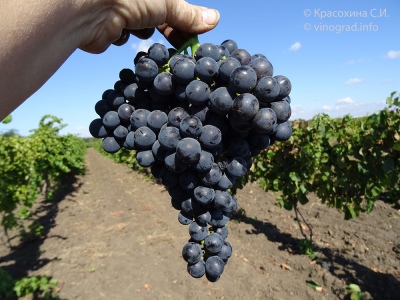
- Authors: Russia
- Appointment: dining room
- Berry color: Navy blue
- Taste: harmonious
- Frost resistance, ° C: -30
- Name synonyms: Gorun, Wasp, Black wine, Horned brush
- Bunch weight, g: 372
- Flower type: bisexual
- Density of the bunch: medium
- Skin: medium
The grape variety called Plechistik Severny is very popular among summer residents. It belongs to the ancient varieties that were grown in the Don for a long period. The grapes are also known under many other names: Horned brush, Goryun, Osypnyak and Black wine.
Breeding history
There is no information on the exact origin. Many indicate that the first bushes were grown in the southern regions of Russia.
The resulting crop is often used to make sparkling wines. Despite the large number of disadvantages, the variety is bred on many plantations, some commercial farms prefer this variety exclusively.
Description
The variety in question is grown as a non-covering crop in the central and southern regions of the country. The plant can withstand temperatures as low as -32 degrees Celsius.
The high decorative qualities of the leaves make it possible to use the vine when arranging a summer cottage. The green walls created look very attractive.
Ripening period
The hybrid is characterized by a medium-late ripening period. At the same time, the temperature in the growing zone largely influences the effectiveness of agrotechnical actions. In the Rostov region, the variety ripens around mid-September.
Bunches
The resulting clusters are small in size, weighing on average only 372 grams. The shape is slightly conical, creating the effect of having shoulders.
With proper handling of the plant, the weight of one bunch can reach 1.5 kg. The harvest takes 130 days to ripen.
Berries
The grapes in question are very often chosen for commercial cultivation. Berries are characterized by the following features:
the density indicator is moderate;
round shape;
weight on average 2.2 g;
color of purple shades;
the skin is firm and thin, with a slight bloom.
Taste
It is the taste that determines the popularity of the variety. The sugar content is 22-24%, the acidity is 8-9 g / l.
The taste is sweet, there is a slight sourness. There are a small amount of seeds inside, they come off the berries very well and quickly.
Yield
Ripe grapes are characterized by their versatility in use. Berries are suitable for decorating desserts or making juices, compotes and fruit platter.
The yield indicator is stable, one bush gives 10 kg of berries. However, to obtain a sufficient indicator, it is necessary to carry out the correct agricultural technology.


Growing features
Among the features of cultivation, several points can be noted.
Top dressing is in progress.
Timely pruning is carried out.
Pest and disease control.
Only with the right approach to the issue can conditions for high yields be ensured.
Landing
There are several guidelines for the landing procedure. They are as follows:
a sunny place protected from the cold is most suitable;
maintain a distance of 1.5 meters;
the minimum pit depth is 50 cm;
the bottom is covered with a fertile layer;
after planting, 2 buckets of water are poured.
The introduction of mineral or organic fertilizers is carried out only when necessary.

Pollination
The pollination process is not a problem. This is due to the fact that the flowers are of both sexes.
Pruning
Features that should be taken into account when pruning Pelchistik Severny grape bushes:
the first pruning is carried out in the first year, you need to leave only one strongest shoot until August;
if in the first year before summer the plant grows to a height of 3 meters, you need to make an additional pruning of 3 leaves;
in the second year, two branches are left, directed in different directions;
at the time of the growing season, all stepchildren are removed;
when the shoot grows up to a meter in length, they are directed towards the bush.
In early spring and late autumn, pruning is done to remove weak or dry shoots. It is not recommended to allow strong thickening, as this can negatively affect the yield indicator, various diseases can develop rapidly.



Frost resistance and the need for shelter
The grapes in question are among those that can not be covered for the winter. This is considered a big plus.
The need for shelter arises only in the first year of planting. This should be done when there is a possibility of a strong drop in the ambient temperature.

Diseases and pests
The predisposition to diseases and pests is quite high. That is why certain processing should be carried out:
3% copper sulfate in the spring;
at the time of the formation of the first 4-6 young leaves, Nitrafen is used.
In the summer, if signs of gray rot are detected, it is recommended to spray the bushes with a manganese solution. Some gardeners recommend covering the plants with gauze bags or special wasp nets, some set sweet traps.

If the grapes are exposed to any disease or insect, this is always reflected in its appearance.
Storage
The fruits are stored at temperatures from 0 to 4 degrees Celsius with humidity above 90%.As a rule, there are no problems with transportation, since the skin is strong. The appearance of rot or broken surfaces is not allowed.
This variety has long been loved by gardeners. It is considered a classic, it has successfully passed several stages of testing in various growing conditions.











































































